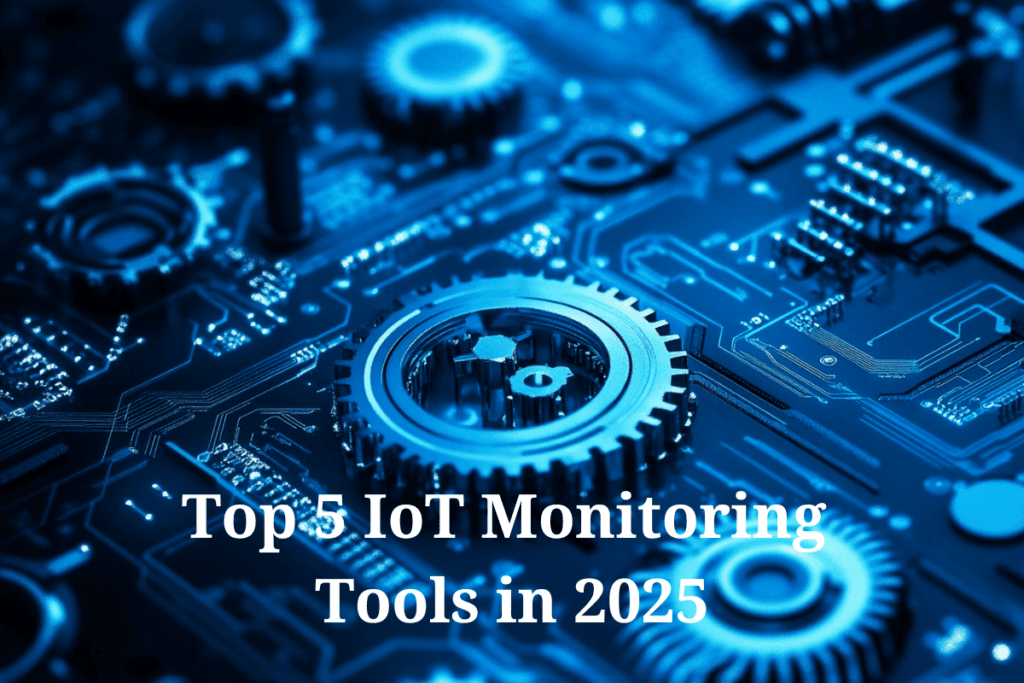Top 5 IoT Monitoring Tools in 2025
Boost Efficiency & Security
Introduction
The Internet of Things (IoT) is rapidly transforming industries, connecting billions of devices to the internet and enabling automation at an unprecedented scale. From smart homes and wearable health devices to industrial machinery and city infrastructure, IoT is driving innovation and efficiency in countless areas. However, managing IoT devices, handling their vast amounts of data, ensuring security, and integrating them with enterprise systems require a robust and scalable infrastructure. This is where IoT monitoring tools become essential, providing the solutions needed to oversee and optimize these complex networks of connected devices.
What is an IoT Platform?
An IoT platform is a multi-layered technology solution that facilitates seamless communication, data management, and automation for IoT devices. Acting as the backbone of an IoT ecosystem, it provides the essential tools and services to connect hardware, process and analyze data, ensure security, and integrate with external applications or enterprise systems. These platforms support the lifecycle of IoT operations, from device onboarding and real-time monitoring to advanced analytics and system integrations, making it easier for businesses to scale their IoT initiatives. Whether it’s enabling predictive maintenance for industrial equipment or ensuring the reliability of a smart city network, an IoT platform is critical for unlocking the full potential of IoT technology.
Key Components of an IoT Platform
IoT platforms typically consist of the following components, providing a comprehensive framework to manage connected devices and their data:
1. Device Management
- Handles the provisioning and onboarding of IoT devices, ensuring they are securely connected to the platform and ready for operation.
- Enables remote monitoring and control, allowing administrators to supervise devices and make adjustments as needed, even from a distance.
- Facilitates firmware and software updates over the air (OTA), keeping devices updated with the latest features and security patches.
- Includes fault detection and diagnostics tools to quickly identify and resolve issues, minimizing downtime and maintaining efficiency.
2. Connectivity Management
- Supports multiple communication protocols such as MQTT, HTTP, CoAP, and LoRaWAN to ensure compatibility with a wide range of IoT devices.
- Manages network connectivity across various technologies like Wi-Fi, cellular (3G, 4G, 5G), LPWAN, and Bluetooth, providing flexibility in deployment options.
- Ensures reliable data transmission by monitoring latency, optimizing bandwidth usage, and maintaining stable connections, even in challenging network conditions.
3. Data Management & Processing
- Collects and aggregates data from connected devices, creating a centralized repository for analysis and decision-making.
- Incorporates edge computing for local processing and analytics, reducing data transfer costs and enabling real-time insights at the device level.
- Provides cloud-based storage and advanced big data analytics, allowing large-scale data sets to be analyzed for trends, patterns, and actionable insights.
- Offers data visualization tools and customizable dashboards, making it easy for users to interpret data and make informed decisions.
4. Security & Compliance
- Implements robust authentication and access control mechanisms to protect against unauthorized access to IoT devices and data.
- Uses encryption and secure communication protocols to safeguard data during transmission, ensuring its confidentiality and integrity.
- Adheres to industry standards and regulations such as GDPR, HIPAA, and ISO 27001, ensuring compliance with legal and security requirements while building trust with users.
5. Integration & APIs
- Enables seamless integration with enterprise applications like ERP, CRM, and DevOps tools, streamlining workflows and enhancing operational efficiency.
- Provides well-documented APIs for custom development and third-party integrations, enabling businesses to tailor the platform to their specific needs.
- Supports webhooks and event-driven architectures, allowing automated responses to real-time events and improving system responsiveness.
These components work together to create a robust and scalable IoT platform, empowering businesses to harness the full potential of their connected devices and make data-driven decisions with confidence
Types of IoT Platforms
IoT platforms can be categorized based on their core functionalities and deployment models:
IoT platforms can be categorized based on their core functionalities and deployment models. Each type serves a specific role in the IoT ecosystem, helping businesses and developers streamline their IoT operations and drive innovation. Here’s a closer look at the different categories of IoT platforms:
1. Connectivity Platforms
These platforms specialize in handling the communication and network management between IoT devices. They ensure seamless data transfer, device-to-device communication, and connection stability, which are crucial for smooth IoT operations. Connectivity platforms often support multiple network protocols, such as Wi-Fi, cellular, or LPWAN.
- Examples: Particle, Soracom
2. Device Management Platforms
Device management platforms are essential for provisioning, monitoring, and maintaining IoT devices throughout their lifecycle. They allow businesses to remotely update firmware, troubleshoot issues, and ensure devices are running efficiently and securely. These platforms are particularly useful for large-scale IoT deployments with hundreds or thousands of devices.
- Examples: Azure IoT Hub, AWS IoT Core
3. Application Enablement Platforms (AEPs)
Application enablement platforms provide the tools developers need to create, deploy, and manage IoT applications. They often include features like data analytics, visualization, and workflow automation, enabling businesses to extract actionable insights from IoT data. AEPs are a great choice for businesses looking to build custom IoT solutions without starting from scratch.
- Examples: ThingWorx, Losant

4. Cloud IoT Platforms
Cloud IoT platforms are offered as PaaS (Platform as a Service) by cloud providers. They combine scalability, reliability, and advanced data analytics capabilities. These platforms allow businesses to store, process, and analyze data collected from IoT devices, providing a centralized infrastructure for managing IoT ecosystems across geographies.
- Examples: AWS IoT, Google Cloud IoT, IBM Watson IoT
5. Industrial IoT (IIoT) Platforms
Industrial IoT platforms are designed to meet the specific needs of industrial automation and manufacturing. They integrate IoT capabilities with existing industrial control systems, enabling predictive maintenance, real-time monitoring, and improved operational efficiency. These platforms often cater to industries like energy, manufacturing, and transportation.
- Examples: Siemens MindSphere, GE Predix
By understanding the unique functionalities of these platform types, businesses can select the right IoT platform to meet their needs and unlock the full potential of their IoT initiatives
IoT Monitoring Platforms and DevOps
IoT Monitoring platforms play a crucial role in DevOps for IoT, facilitating automation, continuous integration, and continuous deployment (CI/CD) for IoT applications. Key aspects include:
- Automated provisioning and configuration of IoT devices.
- Monitoring and logging using DevOps tools like Prometheus and Grafana.
- Secure deployment pipelines with containerized IoT applications.
- Edge computing orchestration with Kubernetes and cloud-native technologies.
Top 5 IoT Monitoring Tools in 2025
1. Skyspark
**Skyspark** is here to revolutionize the way you manage IoT systems! This powerful, scalable platform is built to support Java-capable devices while delivering top-notch data processing and security monitoring. Whether you’re managing large-scale IoT deployments or just starting out, Skyspark ensures reliability, performance, and peace of mind.
Why Choose Skyspark?
- Spot Problems Fast! Real-time data analytics and anomaly detection help you tackle issues as soon as they arise.
- Seamless Integration with a wide range of industrial IoT applications keeps your systems running smoothly.
- **Scales With You**—perfect for businesses of all sizes, from startups to large enterprises growing their IoT networks.
Who’s It For?
Perfect for building automation, energy management, industrial monitoring, and any application where precision is key.
Trusted across industries like manufacturing, energy, and commercial building management, Skyspark stands out for optimizing energy use and streamlining operations. Its advanced machine learning algorithms detect inefficiencies, irregularities, and potential faults in real time. The result? Lower operational costs, better system performance, and a more efficient operation.
With a user-friendly interface and detailed reporting tools, Skyspark empowers you to make smart, data-driven decisions effortlessly. Ready to take control of your IoT systems? Discover the power of Skyspark today!
2. Particle
Particle is your all-in-one solution for building and managing connected devices at scale! With a seamless integration of hardware, software, and cloud services, Particle makes IoT deployment easy so you can focus on what really matters—innovation.
Why Choose Particle?
- Secure and reliable cloud platform: Keep your data safe and your devices connected with Particle’s powerful cloud infrastructure.
- Flexible connectivity options: From cellular and Wi-Fi to BLE, our connectivity solutions let your devices thrive in any environment—whether it’s a busy city, a manufacturing plant, or a remote logistics site.
- Developer-friendly tools: Accelerate your IoT journey with tools like SDKs, APIs, and a user-friendly dashboard designed for rapid deployment and management.
Perfect for: Manufacturing, logistics, smart cities, and any industry looking for scalable, reliable IoT solutions.
Particle simplifies everything! From pre-certified hardware to industry-ready microcontrollers and modules, we help you cut down on development time and costs. Our secure cloud services make device management and real-time data monitoring a breeze.
Ready to take your IoT operations to the next level? Whether you’re building smarter factories, optimizing supply chains, or enhancing urban infrastructure, Particle is here to help you deliver connected solutions that drive efficiency and ignite innovation.
Get started today and see how Particle can transform your business! 🚀
3. ThingWorx (PTC)
ThingWorx is your go-to platform for industrial IoT solutions! Ready to transform how you monitor and manage operations? ThingWorx brings the power of IoT to the industries that need it most, empowering businesses to optimize performance, reduce downtime, and stay ahead in a competitive landscape.
Why you’ll love it:
- Predict problems before they happen with advanced machine learning, saving time and avoiding costly disruptions
- Build applications fast using simple drag-and-drop tools, enabling quick deployment without needing extensive coding skills
- Unlock strong industrial IoT capabilities tailored specifically to meet your operational needs, no matter how complex
Perfect for: Manufacturing, transportation, and energy sectors, as well as any business needing robust IoT solutions for large-scale applications.
Designed with large-scale industrial applications in mind, ThingWorx seamlessly integrates with operational technology (OT) systems, providing a unified platform to connect devices, analyze data, and streamline workflows. Its AI-driven analytics deliver actionable insights to boost productivity, predict maintenance needs, and prevent costly equipment failures. What sets ThingWorx apart is its flexibility in adapting to a variety of industries and use cases, making it a trusted partner for digital transformation initiatives.
Whether you’re managing production lines, optimizing fleet operations, or improving energy efficiency, ThingWorx helps you harness the full potential of IoT. Ready to take your IoT strategy to the next level? Dive into ThingWorx today and unlock new possibilities for growth and innovation!
4. Cisco IoT
Looking for a powerful IoT monitoring tool to revolutionize your operations? Cisco IoT has you covered! This enterprise-grade solution is designed for seamless connectivity, robust security, and unmatched scalability, making it the ultimate choice for modern businesses navigating the IoT landscape.
Why Cisco IoT?
- ⚡ Lightning-fast edge computing for real-time data processing, ensuring your business stays ahead with actionable insights.
- 🔒 Rock-solid security features to protect your network from threats, giving you the peace of mind needed in a connected world.
- 📈 Built to scale effortlessly with your growing enterprise, adapting to your needs as your IoT ecosystem expands.
Perfect for: Smart cities, transportation systems, industrial automation, and enterprise applications needing secure, high-performance networks.
With Cisco IoT, organizations gain the ability to process data closer to the source through advanced edge computing. This enables faster insights, reduces latency, and empowers real-time decision-making for critical applications. Whether you’re managing smart city infrastructure or optimizing industrial processes, Cisco IoT ensures your network is reliable, secure, and ready for the future.
Ready to take your IoT strategy to the next level? Explore Cisco IoT today and experience the power of smarter, more efficient connectivity!
5. EMQX
EMQX is a powerful open-source MQTT broker designed to deliver high-performance communication for IoT applications. Built with scalability and reliability in mind, EMQX supports millions of connections simultaneously, making it a go-to solution for organizations managing large-scale IoT deployments.
Key Features:
- High-speed message processing for real-time IoT monitoring and control, ensuring immediate data delivery across devices.
- Flexible deployment options that allow businesses to run EMQX in cloud environments, on-premise data centers, or hybrid setups, enabling seamless integration into existing infrastructures.
- Advanced security features such as authentication, data encryption, and access control to safeguard sensitive IoT data and maintain regulatory compliance.
Best For: Telecommunications, finance, logistics, and any business requiring robust IoT communication solutions.
EMQX ensures reliable, scalable, and efficient MQTT messaging, making it an ideal platform for connecting and managing millions of IoT devices. Its open-source nature enables businesses to adapt and customize the platform to meet unique operational needs, giving them the flexibility to innovate and grow without limitations. Whether you’re monitoring smart devices, enabling industrial automation, or building IoT applications, EMQX provides the tools you need for seamless and secure device communication.
Comparison of IoT Monitoring Tools
| Tool | Best For | Key Feature |
|---|---|---|
| Skyspark | Industrial automation | Real-time data analytics |
| Particle | Manufacturing & logistics | Cloud-based IoT management |
| ThingWorx | Enterprise solutions | AI-powered analytics |
| Cisco IoT | Smart cities & security | Edge computing integration |
| EMQX | Telecommunications | High-speed MQTT messaging |
Final Thoughts
Choosing the right IoT monitoring platform is crucial for optimizing IoT performance, ensuring security, and gaining actionable insights from your connected devices. Whether you’re managing industrial automation, smart city applications, healthcare devices, or logistics tracking, these platforms help streamline operations and prevent potential issues before they arise. These top IoT monitoring tools offer cutting-edge solutions for 2025, enabling businesses to drive efficiency, enhance reliability, and stay ahead in a rapidly evolving digital landscape.
Which of these IoT monitoring tools do you use? Share your thoughts in the comments!
Do you know about automated incident management? Learn more in the following post to supercharge your devops skills. Automated Incident Response: Best Practices with Tools like PagerDuty and Opsgenie



